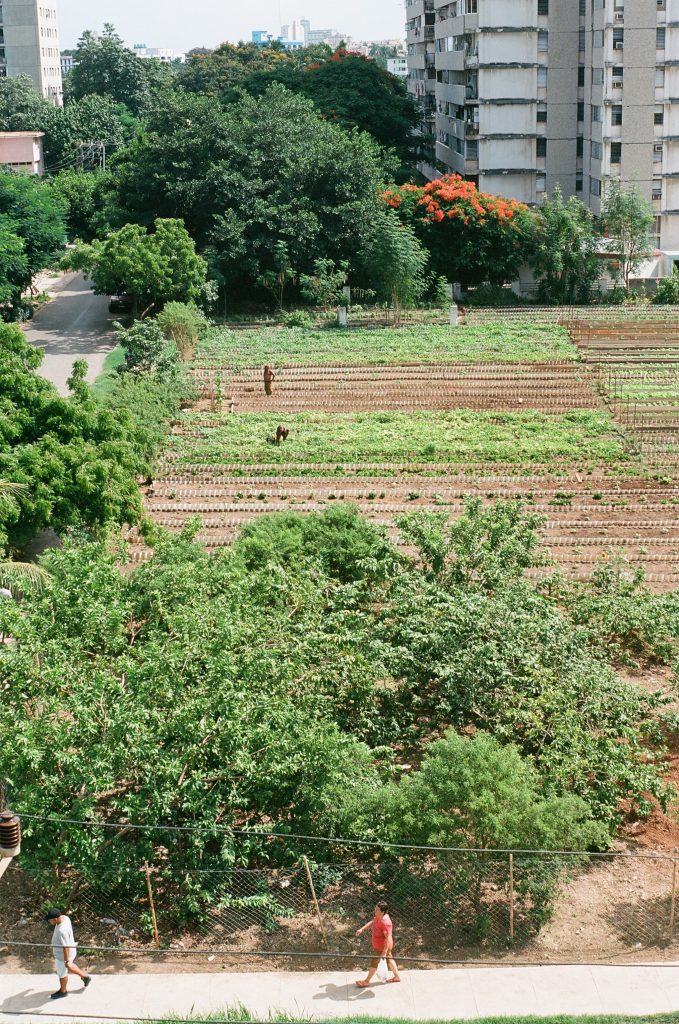
Tall, faceless apartment buildings dot the Havana skyline around me. Stacks of weathered concrete and glass loom in every direction. But within this anonymous border of concrete giants lies a verdant urban void, where rows of clay tiles line an expanse of leafy vegetable beds. The street corner where I stand bustles with activity—neighbors chat, shoppers heckle, and flies dodge swinging water bottles—all under the corrugated overhang of a market stall in the expansive open space called Organopónico La Sazon. I had traveled to Cuba in June 2016 not as a then-ubiquitous American tourist but instead as a graduate student of both architecture and environmental science. I set out to learn lessons from Cuba’s cities that I hoped would describe how Cuba survived a food crisis I feared parts of my country—and the world—might someday face.
I went to Cuba armed with a basic understanding of its unique history—I knew that with the collapse of the Soviet Union in 1991, Cuba lost its supply of wheat, beans, and oil almost overnight. Cuba was importing 90% of the fertilizer and pesticides needed to support its system of industrial agriculture from the Soviets, and the Cuban agricultural system was rendered immediately untenable with the USSR’s collapse. I had read reports that tractors were left abandoned in fields and that Cubans were at risk of mass starvation after these imports were ripped from the nation’s grasp. Cuba was forced to develop a way to feed its population of 10.5 million people, 69% of whom lived in cities, without the goods and technology that its entire food system relied upon. Faced with extreme rations, Cubans in cities across the country turned to surrounding parcels of empty land to grow the food they needed to survive.
I had read that in the two decades after this crisis, Havana’s residents converted 135 square miles of land into agriculturally productive space. That is almost six Manhattans of urban agriculture within the city. From balcony gardens and rooftop farms, to collective lots and the fields of Havana’s green belt, residents transformed their city: severe food shortages were overcome, in part, by output from urban farms. By the early 2000s, over half of the fruits and vegetables consumed in Havana were produced within the city. A country previously reliant on imports for 90% of its food was able to feed itself through urban, organic agriculture. This movement represents the largest conversion from conventional to alternative, organic agriculture in the world’s history.
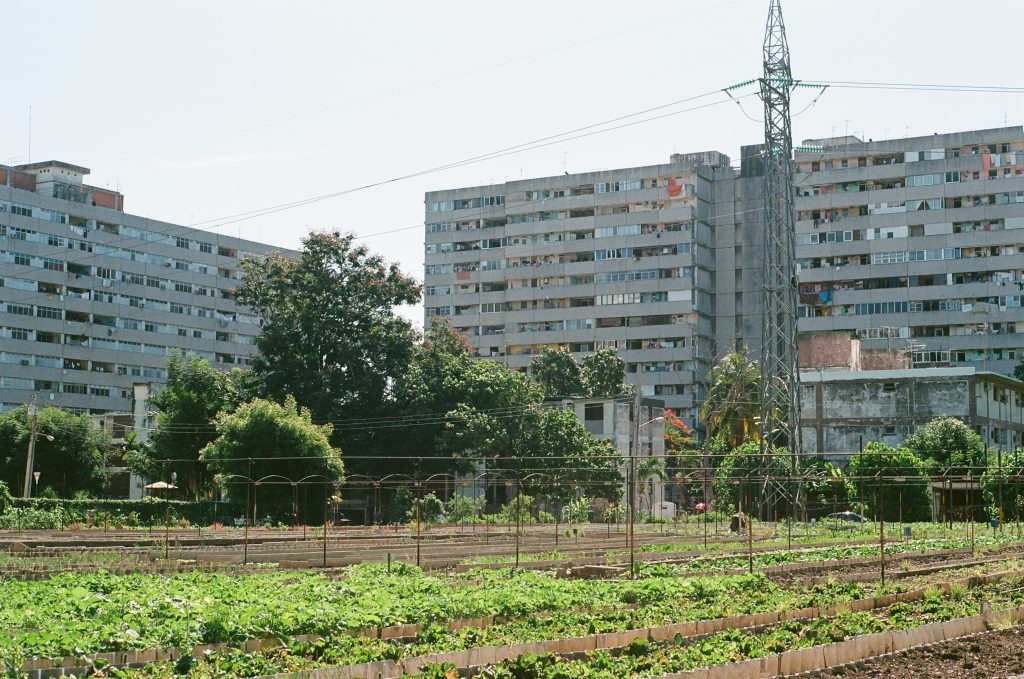
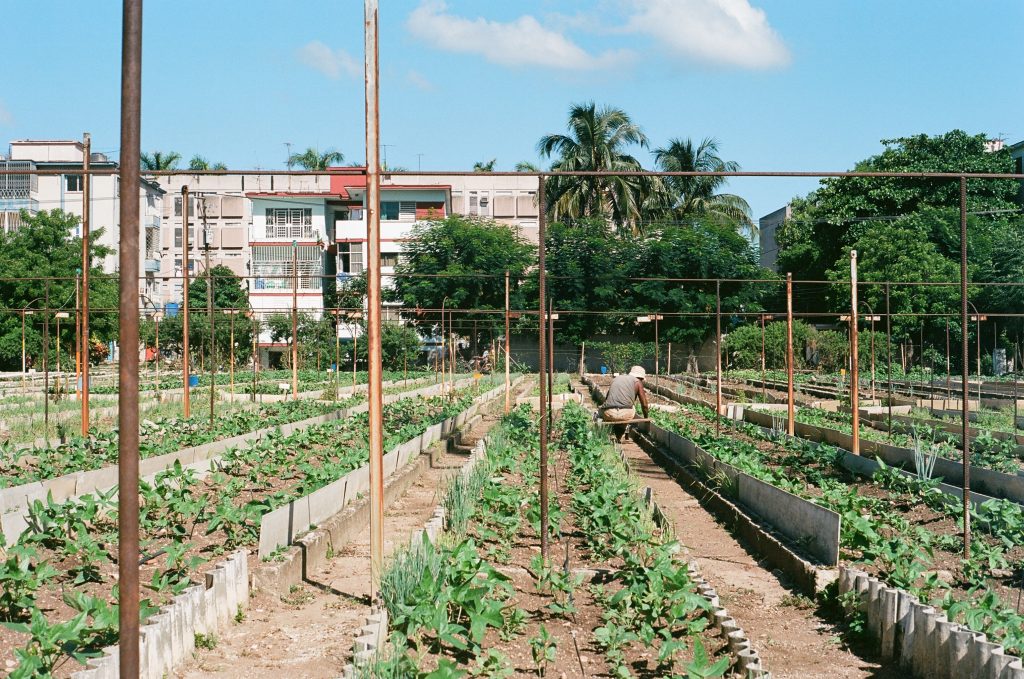
The image of verdant vegetables growing against the backdrop of crumbling colonial homes, and the thought of enough food to feed a nation springing from cracks in the country’s concrete institutions, all seemed unfathomable from my perspective in North America. In the United States and Europe, economists and agronomists alike question whether the relatively low yield from organic, urban agriculture can increase food production enough to feed our expanding global cities. The Cuban system of urban agriculture that I had been reading about suggested to me that these theorists might be missing something and that this system could hold important lessons for us to learn.
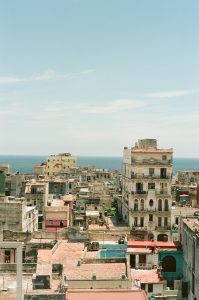
As climate change threatens to accelerate, as oil reserves warn of depletion, and as aquifers risk exhaustion—we might someday have to reckon with the instability of our industrialized food system. If temperatures climb in the Great Plains, if oil reaches $150 a barrel, or if droughts intensify in the Central Valley, aisles of grocery stores in the Northeast might start to look radically different. We won’t see a total collapse like the one Cuba endured, but there could come a time when cities may have to rethink how they get their food from field to plate—a trip that, today, could include flights from Boise to Boston, or semi-trucks from Kansas to California, or maybe cargo ships from Buenos Aires to New York. If that time comes, Cuba’s local, low-input, transport-free system of urban agriculture would be an important model to study. Cuba could hold the answers, not only as a nation that has already run the oil-free experiment, but as a country of cities whose urban fabric has adapted to growing its own food.
I would soon learn, however, that the image I had of a food-secure, urban-farm-fed Cuba was not entirely complete. Nevertheless, the urban agriculture that saved Cuba from starvation 20 years ago does hold some clues to a global conundrum: how can we best feed our growing populations in the world’s rapidly expanding cities? My experiences at four urban farms across Cuba gave me some potential answers to this question.
***
Organopónico Raquel Perez
Driving south-west from Havana to the smaller cities of Cienfuegos and Trinidad is almost like driving back through time. 1950s American cars turn to equine-powered buggies, then into saddled horses, as you leave the relative modernity of Havana behind. But beyond these changes in transportation, you can also read history on the landscape as it slips by. The Cuban landscape has been shaped by its relationship to agriculture, and in driving across the country, you can see that history unfold.
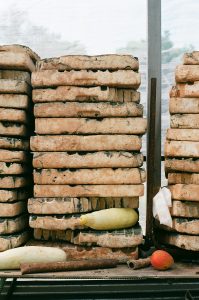
From my perch on a Viazul bus, the only bus company in state-sponsored communist Cuba, I see huge swaths of open, scrubby land fly by. For a nation that endured such a widespread and long-lasting food crisis, you would think all this fertile land would be used for, well, food. But as we drive, I begin to see clues that explained this lack of production. I glimpse a big house in the distance, falling into disrepair, old barbed wire fences, and what looked like a huge grove of fruit trees on the horizon. I see signs of a plantation-based system that is no longer functioning today.
Here is what happened: when the United States ceased trade deals with Castro in 1962, Cuba signed deals with the Soviet Union. These trade agreements limited Cuba’s agricultural products to cash crops like sugar and citrus—so the large plantations that existed before the revolution merely became state-run farms using industrial methods to produce sugar at a large scale. Cuba was dependent on trade for critical goods like oil and for key food products like cereals, meat, and grain.
The shadow of the plantations I could see from the bus would be Cuba’s downfall—by 1989, 60% of Cuba’s planted land was dedicated to sugarcane production, purchased by the Soviet Union at an inflated price. When the Soviet Union collapsed in 1991, it had been providing 85% of Cuba’s imports and receiving 80% of its exports. Without a buyer of sugar and a provider of food, these endless fields of sugar proved much less sweet. Cuba plunged into food crisis, but more importantly, Cuba’s large-scale system of plantation agriculture was completely inoperable without oil, and these farms were abandoned—turning the countryside into the scrubby, uncultivated landscape that I could see out my window.
The decade that followed the collapse of the Soviet Union is known as The Special Period in Time of Peace, a title that also refers to a thinly veiled austerity program mandated in 1991 that today is a stand-in reference for Cuba’s extreme isolationism. It was a “special” decade in which average Cubans lost a third of their daily calories and around thirty pounds. The severity of this crisis led to a surge in resident-initiated urban agriculture, and the Castro government, seeing an opportunity, stepped in to encourage urban farming through the Organopónico program.
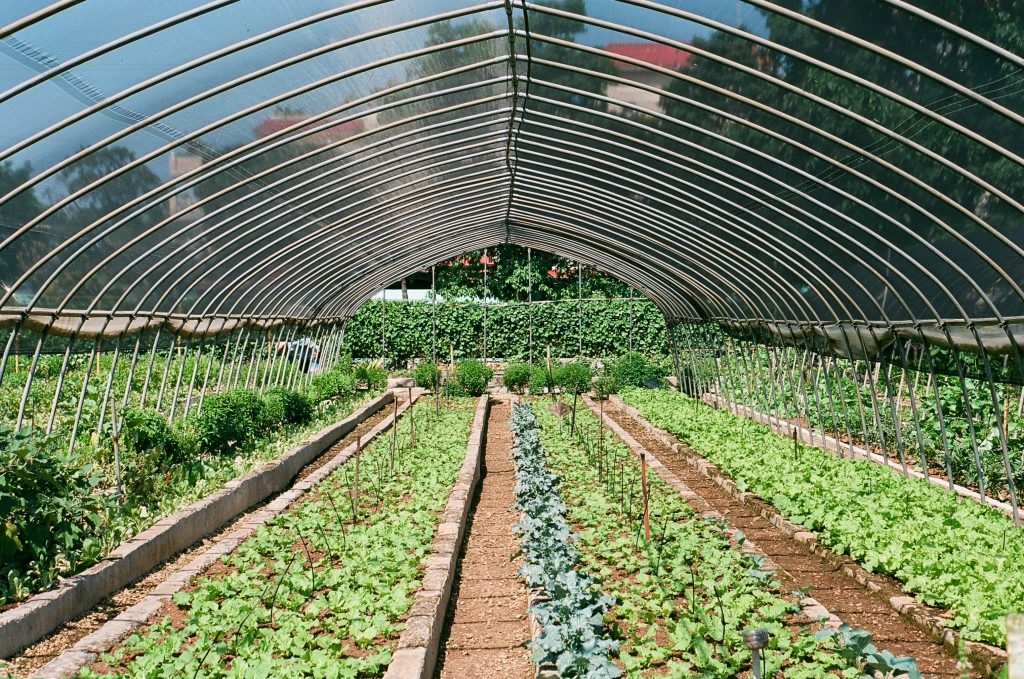
In Havana, Cienfuegos, and Trinidad, three of Cuba’s largest urban areas, organopónicos still proliferate today, and in my drive across the country I visited 14 in total. Castro started the Organopónico program in 1996—it was at the time a new model for profit sharing on urban farms, one of the few ways a Cuban could make money independently of a government job. The Organopónico program allowed urban farmers to augment their base government salary, of around 30 US dollars a month, with earnings from surplus produce.[x] The program offered a way to gain independent income otherwise unheard of in the communist country at the time.
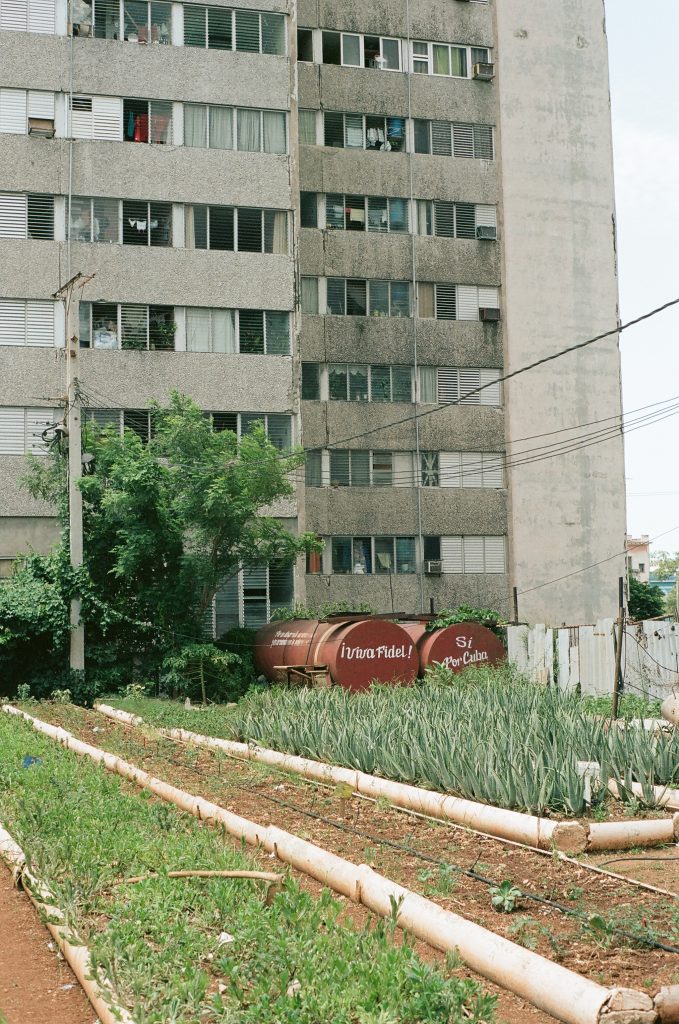
The government support for this program, though not responsible for the initial resident-driven surge of urban agriculture, can be credited for its enduring presence and success. At Organopónico Raquel Perez, in Central Havana, the farm plot abuts a 20-story residential tower, built in the late ‘80s. The lot on which the farm sits was used for construction staging while the neighboring tower was being built. Raquel Perez is a cooperative organopónico, run by a group of residents and overseen by the Ministry of Agriculture. Beyond the ability to grant long-term land leases for farming, the Ministry offers support, in the form of pamphlets, instruction in best practices, and institutional knowledge, for new groups wanting to form organopónicos. At Raquel Perez, opposite its street-fronting market stall, two large red metal water tanks sit next to the tall building. They are emblazoned with white lettering: “¡Viva Fidel!” and “Si Por Cuba.”
And here, despite the many flaws of the communist strong-man government, the benefits of government support for urban agriculture is written on the walls—or water tanks. This type of subsidized farming costs far less—whether measured by cost per calorie or cost per capita—than our US subsidized corn monocultures, which fill our diets with empty calories and throw small farmers out of business in favor of multinational conglomerates. By working at an organopónico, individuals can farm the land and run an enterprise, making a living while producing fresh food in the center of the city. Standing next to a bed of green onions, in front of those red tanks, I found myself wondering what government support for urban agriculture in the US could do for our cities, or for our food system? Could urban farms spring up next to city halls, could farmers’ markets actually compete with the prices in chain grocery stores, could urban gardens become profitable enterprises not community pet projects? Could we develop a system of urban farms, with institutional knowledge and financial security, that could begin to participate in the food systems of our cities?
***
Organopónico La Calzada
In Cienfuegos, on the vast boulevard Calzada de Maximo Gomez, horses pulling wagons are occasionally interrupted by mopeds, and maybe a car or two. The street bustles with activity, with pedestrians walking between shops, to work, or from home. On this main thoroughfare is Organopónico La Calzada, self-proclaimed loudly in thick red letters on an aqua blue market stall. Apart from the bold letters, the market stall is just another building on this street—its height, around 15 feet, matches the shops and houses around it, and even its bright color is matched by pinks, teals, and robin’s egg blues. But this cinderblock stall sits beside a large 2.5-acre lot that is covered in a lush carpet of green vegetables. Though relatively non-descript compared to the rest of Cienfuegos, this market stall would be as foreign in any of our US cities as Castro himself. The market stall, a form of which exists at every organopónico, is an essential piece in the success of Cuba’s organopónico system and a significant takeaway for replication.
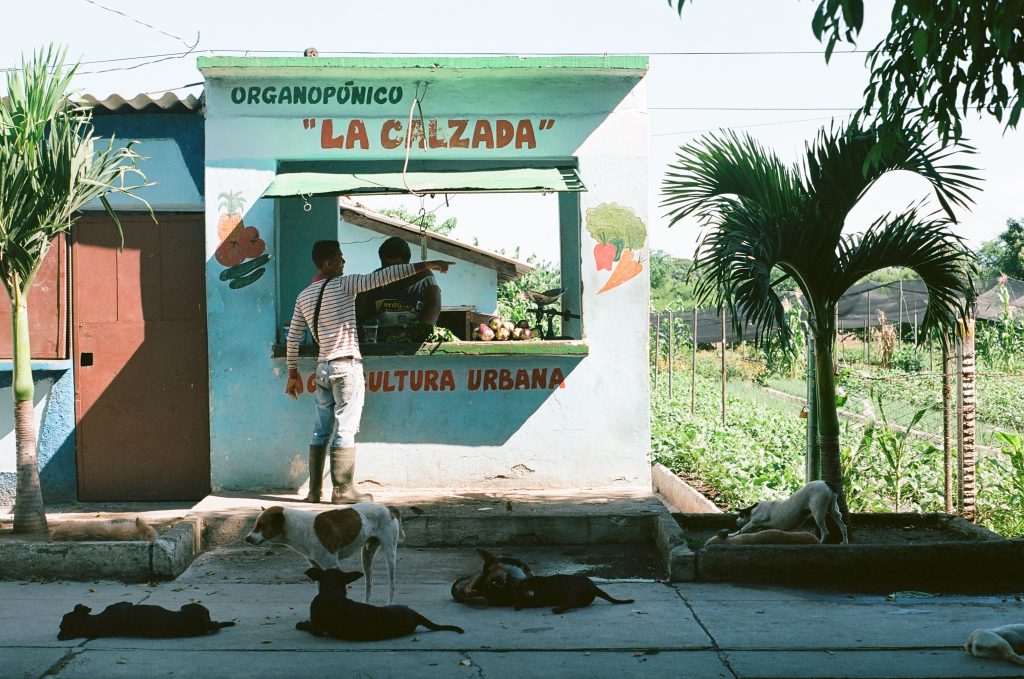
“La Calzada used to be a trash dump,” Roberto*, the farm’s agricultural engineer, explains. “But,” he says, “over 22 years ago it was converted into the organopónico” at the height of the Special Period. The story here parallels that of Raquel Perez: as the food crisis became more severe, the government found people to farm the empty land to ensure fresh vegetables made it into the city. And once you have vegetables growing in the city, you can sell them there too—at La Calzada’s market stall, on one of Cienfuegos’s busiest roads.
The immediacy of this food transfer has larger implications beyond freshness and access, which are undoubtedly important. Roberto holds up a purple eggplant, with a serious look, and says “here it’s one peso,” but “at the agromercado,” (a market selling vegetables brought in from larger farms in the countryside) “this would be 5 pesos.” This price difference astounded me—a 500% increase! For Cubans, who make 700 pesos a month on average, this difference is even more significant. And this price discrepancy, Roberto explains, is precisely due to the farm’s location within the city—transportation costs are “nada,” and the four-peso difference in the cost of the eggplant is roughly the price of the gas needed to bring it into the city.
And imagine the corollary here in the US—imagine if, instead of paying the monetary and environmental price of driving our eggplants from California to New York, we grew them in New York instead? Imagine if our empty lots in Baltimore or New Haven or Phoenix were covered in eggplant, and those eggplants were sold on the spot? Imagine if they were grown and sold around the corner from your school, office, or home, not at a grocery store a 15-minute drive away. We’d probably eat a lot more eggplant.
The power of the market stalls, exemplified by La Calzada’s place in the urban context, is an essential lesson for both our food system at large and our fledgling attempts at urban agriculture. As I left La Calzada, I saw Roberto laying out hundreds of bright tiny peppers, the size of a quarter, to dry in the sun. They were fire red, lime green, orange and yellow. I wished I could have picked some up on my way home.
***
Organopónico San Isidro
Back in Old Havana, sandwiched between two crumbling buildings on a treeless street, is the urban farm San Isidro. It’s hard to imagine a more unlikely place for a farm—if you walk a few blocks in any direction you would be hard pressed to find even a small weed growing on the hot, dry and dusty streets. It looks like this block hasn’t seen water in months. But behind a small storefront grows a swirling mass of green vines. Bright pink magenta flowers offset the green, the most vibrant colors of all on the street of dirty browns, light teals, and faded pinks.
The first two times I walk by San Isidro, a line of customers snake down the block, queuing in front of an aqua blue stall inside metal gates. I try to talk to the patron farmer Raul*, but because of the crowds he says “come back on Monday” the first time, the second time “tomorrow, tomorrow, I can talk tomorrow.” So “tomorrow” I came back, and after waiting for the line to clear, Raul led me through the big metal gates, past the small market, and into the farm.
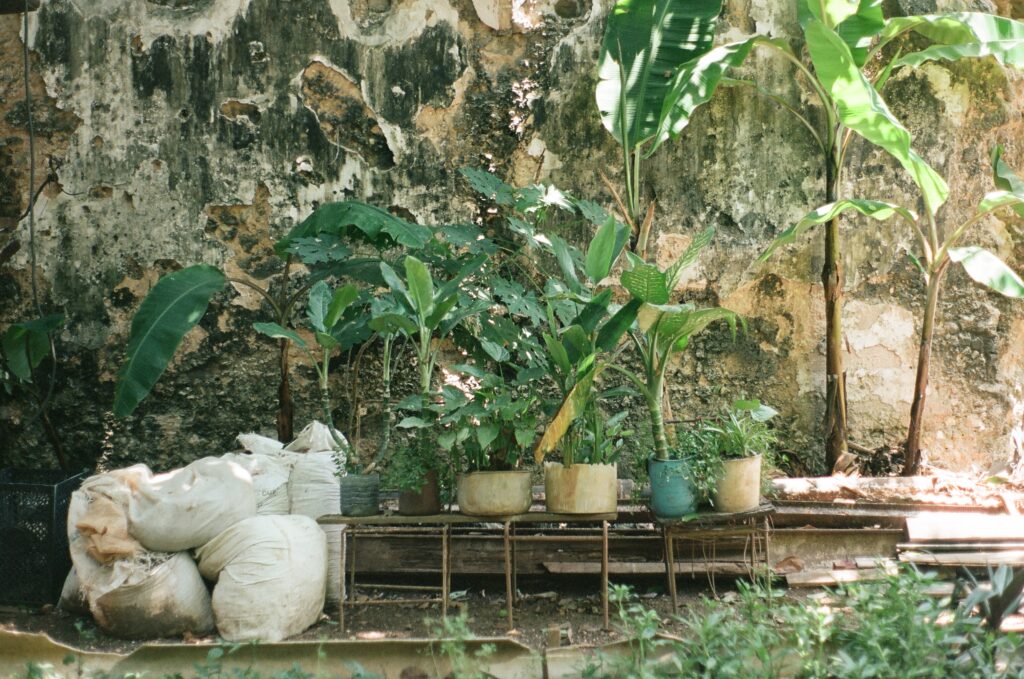
At first glance, this was unlike the other farms I had seen—it was small, shaded by the surrounding buildings, and had strange looking plants—and I soon found out why it looked so different. San Isidro had no well, unlike most other farms in the city. Raul was dependent on fickle urban infrastructure for water, a system that could be shut off at the government’s whim or rationed for months at a time during drought. Because of this uncertain water access, Raul grew medicinal herbs—not the green onions, eggplants, and peppers that I had seen at other organopónicos.
Raul took me, with great pride, to each bed where he explained how every plant or bush might remedy a specific malady of his customers. He explained that in the 1990s the land was an organopónico under the government program, and people sold vegetables for profit. But the lack of consistent water and the shade from neighboring buildings made growing vegetables a challenge. In the early 2000s farmers switched to growing medicinal herbs because, as Raul clarified, “aloe Vera doesn’t need water.”
Raul then led me over to the side of the farm next to one of the adjacent building’s walls, with peeling paint and chunks of concrete missing from its surface, and pointed to six large water jugs sitting on the ground. He described how he has to carry water in these containers from his house to the farm, because government workers broke the underground municipal pipe that brought water to the lot. He does this almost every day, having no other choice.
Because of him, plants still grow, and people still get access to herbs that support their health. Raul and San Isidro demonstrate a fundamental challenge facing urban agriculture—access to, and sometimes competition for, water. But this farm also indicates a solution—different plants can be grown in different places depending on the land’s conditions. And on parcels of urban land that have difficulty getting water, or in places where water is scarce, the land can still be used productively to bring a resource to the center of a community.
***
Organopónico Vivero Alamar
At Organopónico Vivero Alamar, Miguel Salcines greets me at one of the high black gates to the farm. He is its founder, tall with a big smile on his lined face, dressed head to toe in denim with a crumpled hat and brown work boots. Alamar is one of the suburbs across the bay from Old Havana—I rode through the sixty-year-old harbor tunnel in a 1980s Russian car that began to smoke once we had reached the other side. The driver told me the soviet engine doesn’t like the salty air.
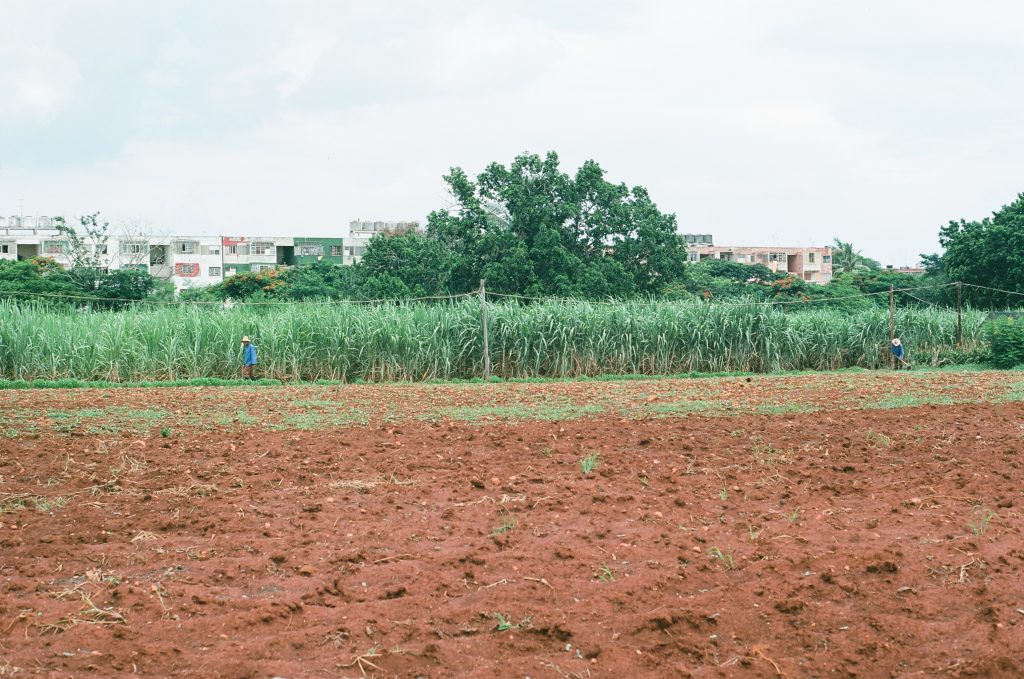
Alamar is the largest public housing project in Cuba—with 100,000 residents—built in the late 1970s and made possible by the tunnel’s construction in the decade before. You can easily pick it out from Google’s satellite view—hundreds of long, rectangular apartment buildings arrayed in odd geometric patterns on large street blocks. But amidst this mess of five-story white and grey rectangles is a concentrated pattern of smaller green and brown shapes. The crop rows at Vivero Alamar, the largest organopónico I saw, are visible from Google-space. They sit smack in the middle of one of the largest housing projects in the world.
Salcines takes me into the farm for a tour and first explains that this large parcel of land, around 27 acres, was initially put aside for a hospital in the center of the Alamar housing project but construction stopped shortly after the Soviet Union fell in 1991. Encouraged and enabled by the government, Salcines started farming the land instead. Today he grows food in the middle of this immense density of people, a population that otherwise might have difficulty getting fresh food.
This timing makes the farm about 20 years old, but Salcines tells me that, at Alamar today, his farming techniques are anything but outdated. We walk by shaded hoop houses, piles of covered compost, patches of corn, and a few concrete beds growing not vegetables but worms. As we walk the extents of the farm, Salcines explains that he has learned in 20 years that intensive organic farming is all about the soil— “soil is your money.” At Alamar they feed cows not for meat but for compost—a far cry from the industrial feedlots of America. “Bugs not chemicals” is another Salcines phrase, which explains the worms. His approach now is to “complement the soil, not push it,” and to “renovate what is in the ground, not conserve it.” Salcines speaks of reorienting himself to the world of micro-organisms in the rust-red soil beneath our feet.
We walk past a variety of structures on the farm, storage sheds, field shelters, and a few market stalls. One building has a window that is clearly repurposed from a 1950s bus. Another room has a variety of bottles and containers laid out on counters and shelves, full of pickled vegetables and canned sauces. There are soda bottles and old jam jars, beer bottles and larger canning jars, in turn beet red, carrot orange, and mustard yellow. Salcines explains that to increase profits he is trying to process the vegetables, and this pickling is his way to add value. But even getting things like packaging materials is hard in Cuba. “What we really need,” he jokes, “is a Home Depot.”
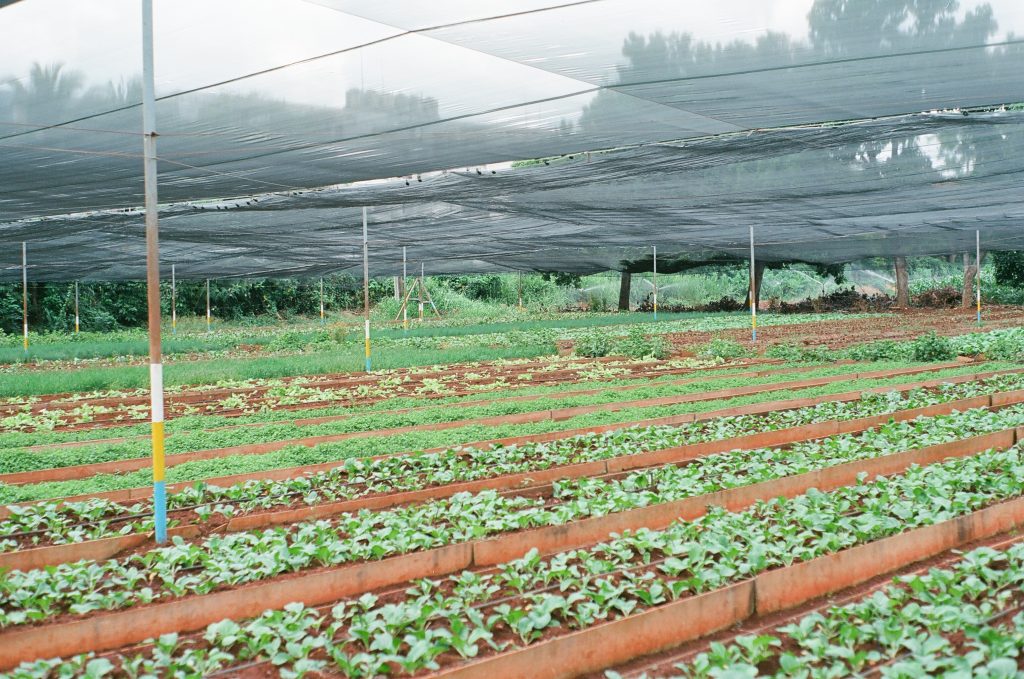
As we walk by row upon row of lettuce under shaded mesh canopies, and by fields of swaying corn, it strikes me that despite having so little, Cuba—through farmers like Salcines—has become expert at what we in the States are just beginning to truly appreciate: organic farming. But Salcines declares that the most important impact organopónicos have had on Cuba is their social benefit—the farm employs 150 people, all of whom share in its profits. And as I stand in front of a corn field backed by one of the areas’ typical concrete-block apartment buildings, I think the immediate access to fresh food in one of Cuba’s poorest and densest neighborhoods is of societal value as well. And standing there I know that this model of community run, government supported urban agriculture, in the middle of a housing project, could have huge societal benefit—for health, food access, and urban employment—in some of the most dense and underserved areas of the US as well.
Vivero Alamar’s market stalls, open to the street, sit under roofs lined with dried banana leaves. The counters’ fronts are painted aqua blue with decals of pineapples, coconuts, and sunflowers, which I just make out behind the cluster of neighborhood shoppers. Green bananas fill red crates, chives stack in neat bundles, and bags of nuts sit in metal baskets. Salcines picks up a few mangoes and gives them to me as a parting gift. They are still the most flavorful I’ve ever had—so good I wanted to smuggle one home in my checked backpack the next day, to my dense American city of New Haven that struggles with its own problems of access to fresh and healthy food.
***
After visiting 20 urban farms spread among four of Cuba’s largest cities, I look back to my first impressions of Organopónico La Sazon with new perspective. I now see trends in one organopónico that extend to a broader system—a system of small urban farms institutionalized and regulated for a nation that still has difficulty with food access. I now see the potential of a government-supported system that lets urban farms compete with high-rise buildings on the real estate market. I now see the market stall not only as an effective community gathering space but also as a place of on-site vending that disperses affordable produce within steps of where it is grown—no gasoline necessary. And I now see La Sazon’s surrounding apartment towers not as anonymous soviet architecture but as densities of people in close proximity to cheap, fresh produce.
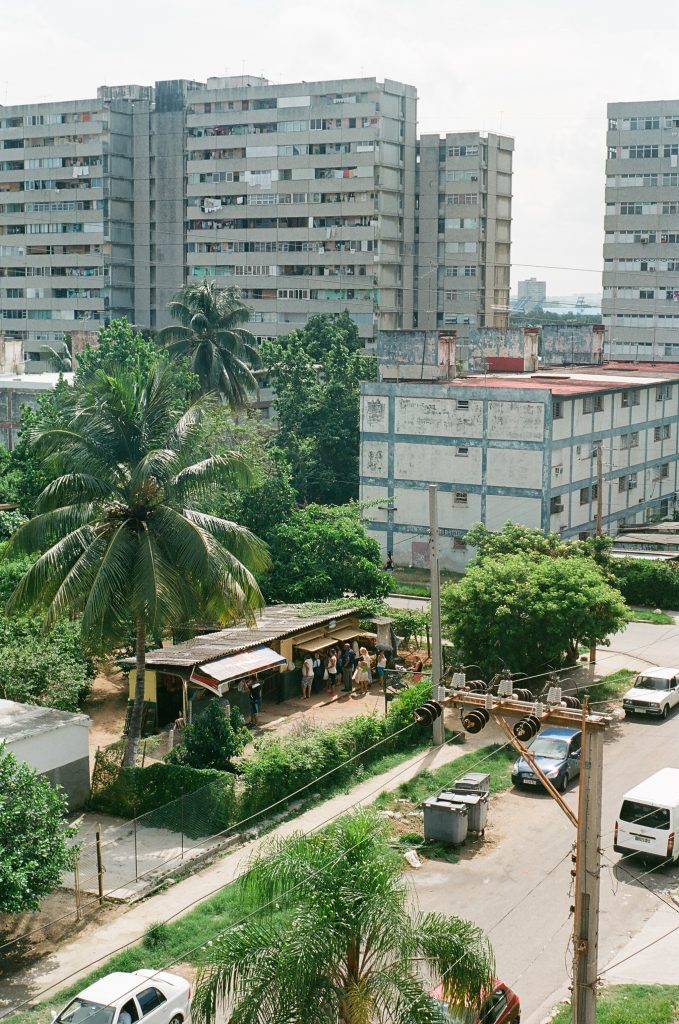
There are, of course, reasons that this system was able to emerge in Cuba specifically, and the nation’s unique history does challenge the potential for replication. The extreme extent and duration of Cuba’s food crisis, the strength of their centralized government, and their suppressed land values are just a few of these reasons. But the spatial adaptations developed within the Cuban urban fabric—the market stalls, the drought solutions, and the farm’s proximity to dense housing—are not subject to unique political or economic context and could be implemented in cities across the globe that face issues of food access.
Much of the world looks down on Cuba, as either a last bastion of communism, a harborer of political criminals, or a “third-world” country held back from economic progress by political adversaries. But the reality is that we, the US and the rest of the world, have much to learn from Cuba. And our cities, as urban populations continue to grow, have much to gain from considering the Cuban system of local urban agriculture. One day, in the not so distant future, we might want to trade our tractors, semi-trucks, and cargo ships for the community benefit and sustenance of their urban farms.
***
Materials consulted
Carey Clouse, Farming Cuba: Urban Agriculture from the Ground Up (New York: Princeton Architectural Press, 2014), 35 and 44.
D.J. Connor, “Organically grown crops do not a cropping system make and nor can organic agriculture nearly feed the world,” in F. Crop. Res. (2013), 144, 145-147.
JP. Diaz and P. Harris, “Urban Agriculture in Havana: Opportunities for the Future,” In Continuous Productive Urban Landscapes: Designing Urban Agriculture for Sustainable Cities, edited by A. Viljoen, (Oxford: Architectural Press, 2005).
Peter Rosset and Medea Benjamin, ed., The Greening of the Revolution: Cuba’s Experiment with Organic Agriculture (New York: Talman Co, 1994), 15, 17, and 34.
Julia Wright, Sustainable Agriculture and Food Security in an Era of Oil Scarcity (London: Earthscan, 2009), 3-4.